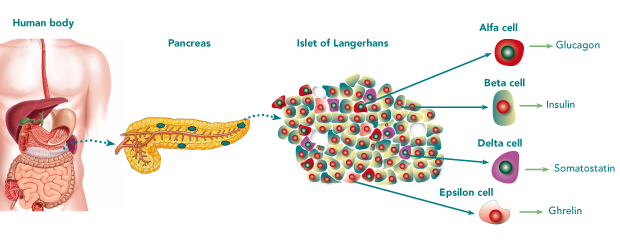Diabetes as a disease
Endocrine and exocrine pancreas – two sides of one organ
The pancreas is one of the organs in the metabolic and the endocrine systems in the human body. The pancreas consists of both an endocrine, or hormone producing part and an exocrine, or digestive part. The latter of the two is the largest by mass, comprising 99% of the volume. It is built from ducts, producing and secreting a mix of substrates for digestion of fat and proteins. Small cell patches of the endocrine pancreas, islets of Langerhans, are spread out between the ducts.
Islets of Langerhans are embedded in the pancreas like raisins in bread. The islets themselves consist of alpha, beta, delta, and epsilon cells, with beta cells dominating in numbers. Islets natural environment is thus a complex system of different types of cells and substances.

Pancreas is one of the organs participating in metabolism. It contains exocrine ducts and endocrine islets of Langerhans. The latter are dispersed throughout the pancreas like raisins in a bun. The islets are built up to 70-80% of insulin producing beta cells. Alfa, delta, and epsilon cells make up for the rest of the islet’s mass and release glucagon, somatostatin, and ghrelin respectively.
Blood sugar levels are regulated by insulin
One of the main tasks of the endocrine pancreas is to control levels of blood sugar, glucose, in the human body. It does so by producing and releasing an optimal mixture of insulin, somatostatin, and glucagon to the blood.
Insulin is the main hormone, when it comes to metabolism of glucose. It is produced by beta cells. It is the lack of this hormone, or improper usage of it that results in diabetes.
Diabetes
Diabetes is a chronic metabolic disease that influences millions of people around the globe. The main characteristics of diabetes is high levels of blood sugar, glucose, resulting from either insufficient production of insulin or by insulin resistance.
There are two main groups of diabetes:
- Type 1 diabetes – results from insufficient insulin production, when beta-cells in the pancreas are destroyed; this group of diabetes is often treated with insulin injections or islet or pancreas transplantation
- Type 2 diabetes – results from failure of the pancreatic beta-cells to produce enough insulin for maintaining normal glucose homeostasis; this group of diabetes if often associated with insulin resistance, or inability of the cells in the body to normally react to insulin.
